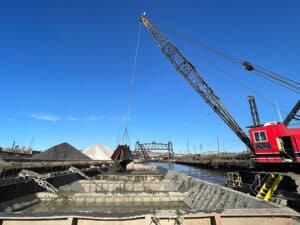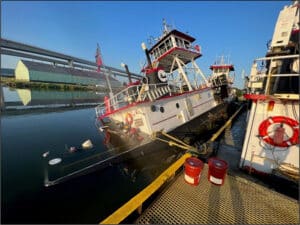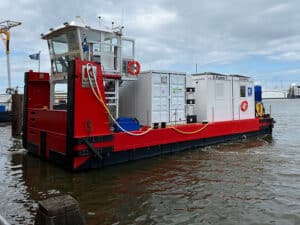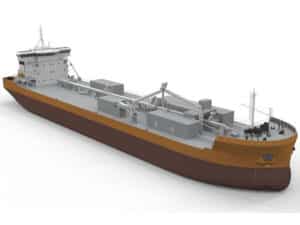
NTSB issues report on towboat sinking
Written by Nick Blenkey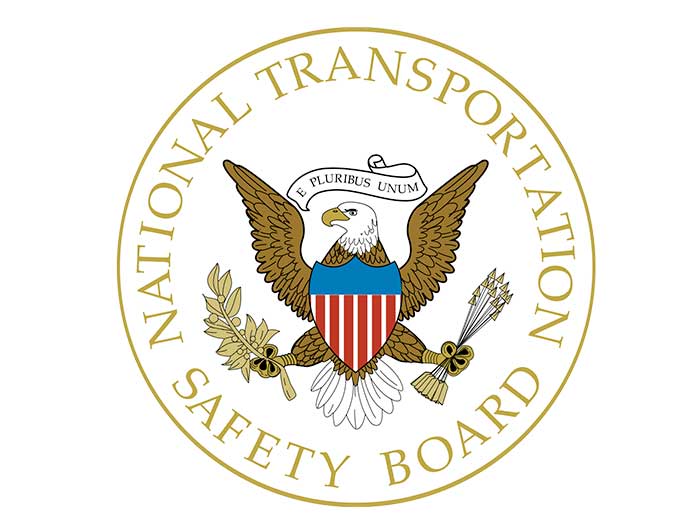
The National Transportation Safety Board has issued its report on the sinking of the 1968-built towing vessel Tom Bussler, owned by McGinnis Equipment Company, Inc. and operated by National Maintenance & Repair of Kentucky.
According to the NTSB report, on January 7, 2019, about 2030 local time, the Tom Bussler was transiting in light boat condition (no tow) upbound on the Tennessee River at mile 15 near Calvert City, Kentucky, when it began flooding and quickly sank in the channel.
Both crew members aboard abandoned the vessel into the river and were rescued by a passing Good Samaritan vessel, the Wepfer Marine fleet towboat George Leavell.
No pollution or injuries were reported. Damage to the vessel was estimated at $297,368, and it was scrapped.
Due to hazardous river conditions, the Tom Bussler could not be salvaged until January 18.
On January 19, says the NTSB report, the vessel was drydocked, and a marine surveyor inspected the vessel for damages and noted several fractures at multiple points in the hull that appeared to “pre-exist the incident.” The upper 12 inches of the port bow corner plating contained an approximate total of 30 inches of fractures, and the starboard bow corner plating contained an 18-inch fracture, all open to a width of 0.25 inch. On the inboard sides of both the port and starboard towknees, the forward extreme of the bow deck plating of each contained a 12-inch transfer fracture open to 0.25 inch. There were also fractures at the base of the headlog plating just starboard of centerline, in the hull bottom plating at a point adjacent to the inboard side of the starboard inboard fair water angle, and in the hull bottom plating inboard from the inboard leg of the port strut. The surveyor also noted that “the lower [5 feet] of the shredded tire bumper on the starboard towknee was adrift and partially missing.” .
According to the NTSB, both the captain and deckhand stated that the bow centerline void had a pre-existing crack slightly above the waterline. The vessel was equipped with two portable sump pumps: one was placed at the bow to dewater the forward voids, and a second pump was placed on the stern to dewater the aft voids. Three voids (centerline forward, port stern and starboard stern) were pumped out daily. Both electric pumps were capable of pumping 43 gallons per minute. They were operated by placing them through a main deck hatch to the void
ANALYSIS
Based on the numerous cracks in the Tom Bussler’s hull found during the postaccident survey, and the documented reports from the crew of water leaking into voids, investigators attempted to determine how long the watertight integrity issues had existed and what actions, if any, had been taken to mitigate them. The vessel had last been drydocked in January 2018, about a year before the accident. No hull repairs related to watertight integrity were scheduled or completed. Throughout 2018, multiple issues with the hull were reported by crewmembers. However, attempts to find the leaks were unsuccessful, and the reported issues were not resolved. Instead, portable pumps were used to control the water ingress. The postaccident survey showed seven pre-existing hull fractures that compromised the integrity of the bow voids, the centerline aft void, and the engine room.
When the vessel was pushing a barge ahead, says the NTSB report, its bow was protected from the bow wave by the barge ahead, and the pre-existing fractures in the hull therefore remained above the effective waterline. However, at the time of the accident, the vessel was under way in light boat condition, without a barge to deflect water, and the bow therefore was subject to the water build up as it moved through the river.
Intermittent flooding of the bow voids likely began as water from the bow wave entered fractures in the forward part of the hull.As the vessel’s forward draft increased (from the flooding), fractures in the hull near the bow were submerged, allowing water to enter into the voids at a higher rate. Additionally, water that went over the bow and onto the main deck flooded the bow voids through fractures and leaking hatches, until the vessel lost stability, capsized, and sank, bow first.
“Although the crew knew about and reported several hull leaks to management in the months prior to the accident, the lack of hull repair evidence and daily pumping of the towboat’s voids indicated that management did not address issues with the vessel’s watertight integrity in a timely manner,” says the NTSB report. “The company’s SMS required senior management to evaluate and determine if reported problems were critical or non-critical and approve and coordinate any maintenance that impaired a vessel’s maneuverability. The lack of action by the operating company to repair these several known hull deficiencies in a timely manner, once identified by the vessel’s crew, was counter to the guidance outlined in their SMS, and was directly related to the flooding.”
PROBABLE CAUSE
The National Transportation Safety Board determines that the probable cause of the flooding and sinking of the tugboat Tom Bussler was the company’s lack of an effective hull maintenance and repair program, which resulted in flooding into the bow voids and engine room through fractures in the hull.
The NTSB report concludes with this caution
Effective Hull Inspection and Maintenance
To protect vessels and the environment, it is good marine practice for owners to conduct regular oversight and maintenance of hulls, including between drydock periods. Regardless of inspection requirements, owners are obligated to ensure vessels are properly maintained, equipped, and operated in a safe condition. Issues with watertight integrity and wastage should be addressed immediately.
Download the NTSB report HERE

